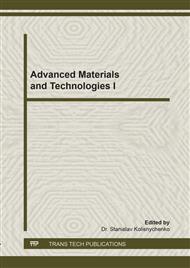[1]
J. U. Anaele, O.O. Onyemaobi, C.S. Nwobodo and C.C. Ugwuegbu, (2015): Effect of Electrode Types on the Solidification Cracking Susceptibility of Austenitic Stainless Steel Weld Metal. http://dx. doi.org/10.1155 /2015/ 213258: p.1 – 7.
DOI: 10.1155/2015/213258
Google Scholar
[2]
y. Cui, C.D. Lundin and H. Vasudevan, (2006). Mechanical behavior of austenitic stainless steel weld metals with microfissures., Journal of Materials Processing Technology. Vol. 171, pp.150-155.
DOI: 10.1016/j.jmatprotec.2005.06.065
Google Scholar
[3]
A. Galal, N.F. Atta, and M.H.S. Al-Hassan, (2005) Effect of some thiophene derivatives on the electrochemical behaviour of AISI 316 austenitic stainless steel in acidic solutions containing chloride ions,, Materials Chemistry and Physics. 89(1): p.38–48.
DOI: 10.1016/j.matchemphys.2004.08.019
Google Scholar
[4]
A.S Afolabi, (2008): Effect of electric arc welding parameters on corrosion behaviour of austenitic stainless steel in chloride medium., AU J.T. 11(3): pp.171-176.
Google Scholar
[5]
F.A. Ovat, L.O. Asuquo and A.J. Anyandi, (2012). Microstructural effects of electrodes types on the mechanical behaviour of welded steel joints., Research journal in engineering and applied sciences. 1(3): pp.171-176.
Google Scholar
[6]
Rathi, Vijayesh, Hunny (2015): Analyzing the Effect of Parameters on SMAW Process International Journal of Emerging Research in Management &Technology. 4 (6): ISSN: 2278-9359.
Google Scholar
[7]
J.F. Lancaster, (1993): Metallugy of welding. Chapman and Hall, London. pp.160-175.
Google Scholar
[8]
C.C. Ugoamadi, (2010): production of manual metal arc welding electrodes with local raw materials. Nigerian journal of technology, vol. 29 no.1, pp.121-125.
Google Scholar
[9]
S. SandeepGarg, I. Kakkar, A. Pandey, M. Gupta, and N. Kishor, (2013), Effect of Different Coating Composition's Rutile-type Welding Electrodes on Undercut Defect in Manual Electric Arc Welding, International Journal of Mechanical Engineering and Research, India. 3(4): pp.381-388.
Google Scholar
[10]
M. Zinigrad, v. Mazurovsky, (2002): Development of new welding materials on the base of mathematical modeling of metallurgical processes: Part 1 and Part 2. Phase Interaction Analysis and Development of the Basic Model, in Proceedings of the Bi-National Israeli-Russian Workshop, Yekaterinburg, Russia. p.277–291.
Google Scholar
[11]
V. Karthik, K.V. Kasiviswanathan, K.Laha and B. Raj, (2002): Determination of Gradients in Mechanical Properties of 2.25Cr-1Mo Weldments Using Shear-Punch Tests. Welding research Journal. p.265 – 272.
DOI: 10.1520/stp10834s
Google Scholar
[12]
H.T. Lee, and T.Y. Kuo, (1999): Microstructure and mechanical properties in alloy 690 weldments. Science and Technology of Welding and Joining 1999 Vol. 4 No. 2. pp.94-103.
DOI: 10.1179/136217199101537626
Google Scholar
[13]
J.E. Ramirez and M. Johnson, (2010): Effect of Welding Parameters and Electrode Condition on Alloying Enrichment of Weld Metal Deposited with Coated Cellulosic Electrodes. Vol. 89, p.232 – 242.
Google Scholar
[14]
N.C. Binkley, G.M. Goodwin and D.G. Harman, (1973), 'Effects of Electrode Coverings on Elevated Temperature Properties of Austenitic Stainless Steel Weld Metal Welding research supplement, AWS National Fall Meeting, p.306 – 311.
Google Scholar
[15]
A.U. Iwuoha, (2013), Influence of electrode coating on mechanical properties of structural steels, Journal of Sustainable Technology. 4 (1): pp.51-80.
Google Scholar
[16]
A. Oyetunji, and N. Nwigboji, (2014), Effects of welding process, type of electrode and electrode core diameter on the tensile property of 304L austenitic stainless steel, Leonardo electronic Journal of Practices and Technologies, ISSN-1583-1078, pp.210-222.
Google Scholar
[17]
E.G. Dieter, and D. Bacon, (1988) Mechanical metallurgy.,McGraw – Hill Book Co. (UK) Limited. Singapore. pp.231-233.
Google Scholar
[18]
W.D. Callister,(Jr.), and D.G. Rethwisch, (2010). 'Materials science and engineering: An introduction. John wiley and sons.8th Ed. pp.397-398.
Google Scholar
[19]
C.F. Campbell, (2008) Elements of metallurgy and engineering alloys., ASM international, USA. pp.135-206.
Google Scholar
[20]
I. Alkahla, and S. Pervaiz, (2017): Sustainability assessment of shielded metal arc welding (SMAW) process. IOP Conf. Series: Materials Science and Engineering. Vol. 244, pp.1-2.
DOI: 10.1088/1757-899x/244/1/012001
Google Scholar
[21]
C.L. Jenney, and A. Brien, (1991): Welding hand Book. American. Welding Society. Vol. 1, p.982.
Google Scholar
[22]
M.P. Groover, (2008): Automation, Production Systems, and Computer-integrated Manufacturing Automation, Production Systems, and Computer-integrated Manufacturing. p.290.
DOI: 10.1108/aa.2002.22.3.298.2
Google Scholar
[23]
J.D. Majumdar, (2006): Underwater Welding – Present Status and Future Scope. Journal of Naval Architecture and Marine Engineering. Vol. 3, pp.39-48.
Google Scholar
[24]
J.W. Fu, Y.S. Yang, and J.J Guo, (2009) Formation of a blocky ferrite in Fe-Cr-Ni alloy during directional solidification, Journal of crystal growth 311: p.3661 – 3666.
DOI: 10.1016/j.jcrysgro.2009.05.007
Google Scholar
[25]
J. Talonen, (2007): Effect of Strain-Induced Α'-Martensite Transformation on Mechanical Properties of Metastable Austenitic Stainless Steels. Doctoral Dissertation Helsinki University of Technology Department of Mechanical Engineering Laboratory of Engineering Materials. pp.31-32.
Google Scholar
[26]
V. Talyan, R.H. Wagoner, and J.K. Lee, (1998) 'Formability of stainless steel Metallurgical and Materials Transactions A. 29A: pp.1-12.
Google Scholar
[27]
D.V. Neff, T.E. Mitchell, and A.R. Troiano, (1969): The Influence of Temperature, Transformation, and Strain Rate on the Ductility Properties of Austenitic Stainless Steels. Transactions of the ASM, 62 (4), pp.858-868.
Google Scholar
[28]
Bressanelli and Moskowitz (1966): Effect of strain rate, temperature and composition on tensile properties of metastable austenitic stainless steels. Trans. Am. Soc. Met. Vol. 59, p.223 – 239.
Google Scholar
[29]
T. Angel, (1954): Formation of martensite in austenitic stainless steels. Journal of the Iron and steel institute. Vol. 177; p.165 – 174.
Google Scholar


